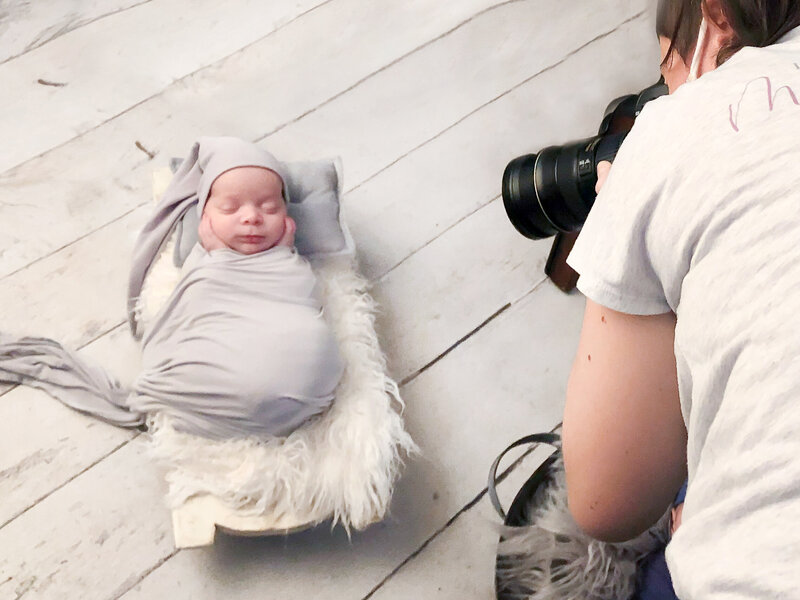Photographing newborns isn’t just about catching cute moments; it’s also about stopping time in a way that lets families remember their favorite times. You are not just getting pictures as a newborn photographer; you are making art that will last a lifetime. It takes skill, care, and knowledge of how to work with these tiny subjects to do the work that goes into newborn photography behind the scenes. We’ll look at what happens at a typical newborn photography session and what makes it such a special art form in this piece.
Preparing for the Session: Setting the Stage
A successful newborn session begins long before the camera clicks. A newborn photographer has to prepare both the studio and the parents. Whether the session takes place in a studio or at the family’s home, creating the right atmosphere is crucial.
First, the studio needs to be set up for comfort. The temperature must be warm enough to keep the baby cozy and relaxed, typically around 75-80°F. A fussy, cold baby can make it harder to capture the perfect shot, so ensuring they are comfortable is key. Soft blankets, props, and outfits are selected carefully to ensure they complement the baby’s features and the overall aesthetic.
Prior to the session, newborn photographers will usually communicate with parents about what to expect and guide them in preparing their baby. Parents may be asked to bring specific items such as pacifiers, extra blankets, or sentimental props that can be incorporated into the session. This much planning makes sure that the parents and the photographer are on the same page, which makes the whole process go smoothly and without any stress.
The Importance of Poses: Capturing Tiny Details
Once the baby arrives and the session begins, the role of the newborn photographer is to gently guide the little one into a range of poses that highlight their natural beauty. Posing newborns requires skill and finesse. Babies are posed in ways that enhance their cuteness and innocence—wrapping them up in soft, textured fabrics, placing them in cocoon-like positions, or delicately cradling them in a parent’s hands.
However, it’s not just about arranging the baby in an aesthetically pleasing way. It’s about creating a connection with the baby, ensuring they feel calm and relaxed. Newborn photographers often work slowly and patiently, knowing that babies can be unpredictable. They may cry, need feeding, or require a break. The photographer must remain calm and flexible, adapting to the baby’s needs while still capturing the desired shots.
Another key part of newborn photography is focusing on the small, often overlooked details. The tiny hands and feet, delicate eyelashes, and soft curls are all elements that can make a photograph truly magical. These close-up shots are just as important as the wide-angle portraits, helping to tell the full story of the newborn’s first moments.
The Power of Lighting and Composition
Lighting plays a pivotal role in newborn photography. Soft, diffused light is essential to create a warm, welcoming atmosphere. Many photographers who specialize in newborns use windows or professional lighting to make sure that every picture is beautifully lit. Harsh lighting can be jarring and unflattering, so the use of gentle, natural light helps highlight the baby’s delicate features.
Composition is another important aspect of the session. A good newborn photographer knows how to frame the shot to emphasize the baby’s beauty and minimize distractions. The background should be simple, often blurred or unobtrusive, so the focus remains on the newborn. The photographer’s attention to detail and framing ensures that every image is a work of art, capturing not just a moment, but the emotion and beauty behind it.
Post-Session: The Magic of Editing
Once the session is complete and the photos are taken, the real magic begins—editing. Newborn photographers carefully select the best images, often tweaking them to enhance the lighting, remove any imperfections, and make the colors pop. The goal is to retain the natural beauty of the baby while making sure the final images reflect the professional quality that families will cherish.
Editing is also a chance to add any subtle effects, like softening the background or ensuring the skin tones are just right. This is where the photographer’s artistic vision truly comes to life, transforming a good image into a great one.
Conclusion: The Lasting Impact of Newborn Photography
Newborn photography is truly an art form, combining creativity, patience, and technical skill to produce timeless images that parents will treasure for years. Behind the scenes, a newborn photographer works to create an environment of comfort, safety, and relaxation while capturing the tiny, fleeting moments that make a baby so precious. The end result is a collection of photographs that not only showcase the newborn’s innocence but also tell the story of their first few days in the world. Every session is unique, and every image is a piece of art that will be cherished for generations to come.
